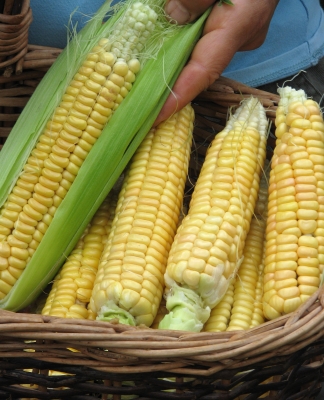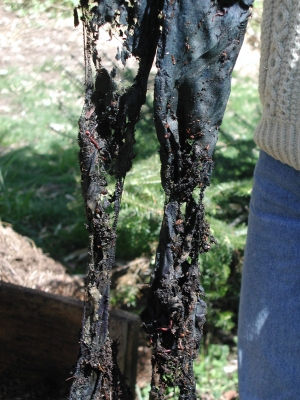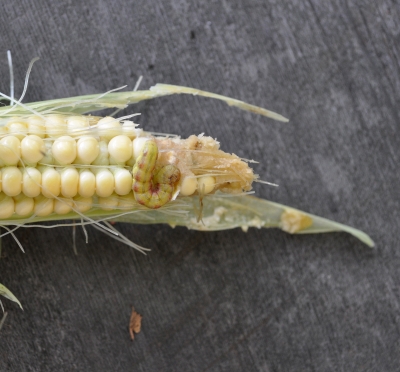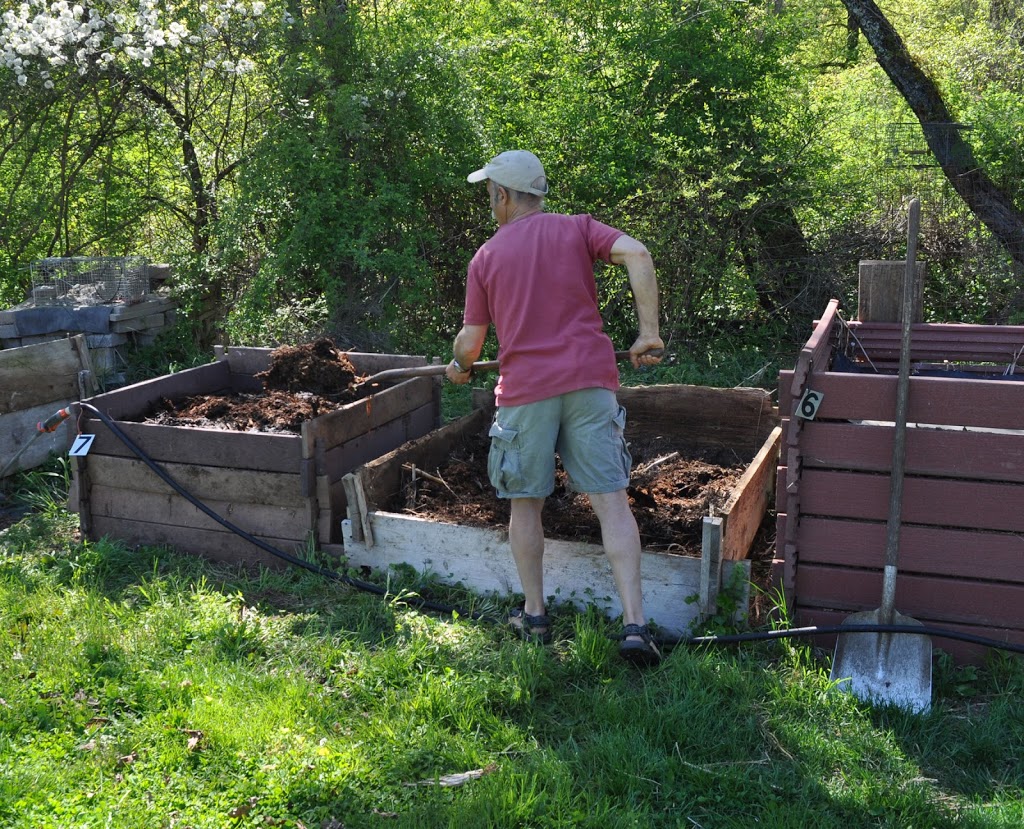Of Corn and Compost
Bed Transformation
In an hour and a half this morning, a 20’ long by 3’ wide bed of spired, aging corn stalks morphed into a bed of succulent, young greenery in the form of endive and Chinese cabbage transplants.
Before beginning this job I harvested what ears were still ripe on the stalks. The yield from this first corn planting was small, both in quantity and size of ears. Old fashioned Golden Bantam, as told by its name, normally yields small ears — but not usually as small as the 3 to 5 inch long ears I harvested. 
Planting in “hills” (clusters of 4 plants) usually provides for adequate pollination, but poor weather at a critical developmental stage might have thrown pollination awry.
At any rate, with ears harvested, I lopped each stalk in half with my Hori-Hori knife, then dug straight down right around the base of each hill to sever the main roots so I could jerk the cluster of stalks up out of the ground. I also cleared away from the bed any weeds, and then carted everything over to a compost pile.
For the return trip from the compost pile, I loaded the cart with finished compost from another pile. An inch depth of compost slathered on top of the old corn bed had it ready to receive the endive and Chinese cabbage transplants I had waiting in the wings. The 40 transplants had grown up during the month of July in a seedling flat and were just ready to outgrow their individual cells. Each went into a quickly made hole jabbed into the ground, the holes 15” apart in each of the two rows running down that bed.
The refurbished bed will provide good eating beginning in early October and, with some covering for protection, on into December.
Compost Discoveries
Besides merely compost, the compost pile often yields some interesting and forgotten objects. (Some annoying things as well, such as those fruit labels glued to the skin of almost every piece of commercial fruit.)
For years now I’ve had trouble bringing myself to tossing anything compostable into the garbage for eventual burial in a landfill. It seems so wasteful of materials and disrespectful to the soil to use it as a dumping ground for cast-offs. Soil is a limited resource so eventually there will be no more acreage to bury trash.
Much of my clothing is cotton, wool, or leather — natural products that would eventually decompose to enrich a finished compost. So I sometimes compost such garments, forgetting that I did so until an uncomposted piece of the garment makes an appearance as I turn the compost pile or shovel out the finished material.

Partially composted Levi jeans
The distinctive zipper and fly snap from my Levi jeans, for example. After three compost cycles, except for the zipper and fly snap, those jeans are surprisingly intact but look more like sheer polyester slacks than Levi’s jeans. In contrast, my daughter’s non-Levi jeans were threadbare after merely one cycle.

Composted (almost) non-Levi jeans
I came upon a not immediately identifiable object today as I shoveled out finished compost for spreading on the endive/Chinese cabbage bed. It was about a half inch thick, almost flat except for some bends, and spongy. What could it be? Aha! The cushioning from my sheep skin booties. Most of the leather portion had decomposed.
My guess is that the bootie was transformed as far as it would go in the near future so I’m not returning it to the new pile for another cycle.
Worms in My Ears (Some of Them)
My ears, now, are relatively large. Corn ears, that is.
Since writing about the diminutive ears from my first planting of sweet corn, I’ve harvested a few ears from my second planting. That second planting went in 2 weeks after the first planting but is ripening close on its heels. Warmer weather earlier in the season compressed those ripening dates.
Just about every ear in this second batch of ears is large (for the variety Golden Bantam) and well filled with kernels. I occasionally find a corn earworm feasting on some of the kernels at the tip of the ear. 
That’s the nice thing about home-grown sweet corn — it’s not nice having the earworms but it is nice not being bothered by them. Corn farmers don’t have that luxury. I just break off the tip with the worm and enjoy the rest of the ear.
The earworms got inside the husks by eating their way down the corn silks. Spraying the corn with the benign biological pesticide Bacillus thurengiensis (sold under such friendlier names as Thuricide), or cutting off or squirting some of mineral oil into the silks right after pollination is complete (3 to 7 days after silks appear) could control this pest. But why bother for an occasional pest that is so easily ignored or removed?



I’ve found corn ears with rows of holes. Eventually I spotted the culprit: a downey woodpecker. I believe it was after the corn earworms. Thus I use Bt on the silks.
Those fruit and veggie stickers make me a little crazy. Why can’t they be compostable too?
I use old clothes, sheets, etc., as “landscape fabric” for my pathways before I put down chips. Works amazing but my husband thinks I’m crazy!
I enjoy reading your posts, even though I’m in Northeastern Alabama where conditions are very different! I have bought and enjoyed several of your books over the years. We used to plant a small vegetable garden in what was a pasture for goats before we owned the land. We have 40 acres, most of which is forested. This year, tired of battling horrendous weeds, we planted only tomatoes. We are using an old cast-iron bathtub for our three tomato plants: a Better Boy, a Bush Goliath, and a Red Beefsteak. In addition, we have a cherry tomato plant that reseeds itself every year. It has taken over a flower bed near our back door and produces enough fruit for several families. I pull out the extra plants and have shared them with friends. Anyway, I enjoy following your garden activities recounted in your email posts and your books. Thanks for all your good advice. Just thought I’d let you know you have readers here in the South!
Thanks for the nice feedback.
So does Levis use a large proportion of polyester woven into the cotton fabric to make its jeans?
I don’t know what the material is except that it’s very slow to compost, if at all.